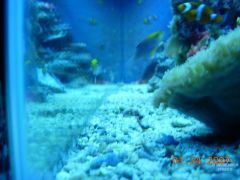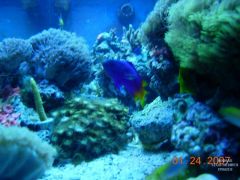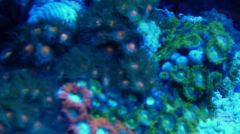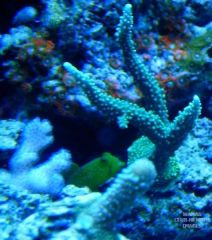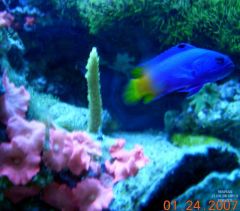
Rascal
BB Participant-
Posts
1,355 -
Joined
-
Last visited
Content Type
Profiles
Forums
Gallery
Events
Store
Everything posted by Rascal
-
From the album: 150 Reef (8/06 - 2/07)
pic -
From the album: 150 Reef (8/06 - 2/07)
pic -
From the album: 150 Reef (8/06 - 2/07)
pic -
From the album: 150 Reef (8/06 - 2/07)
pic -
From the album: 150 Reef (8/06 - 2/07)
pic -
From the album: 150 Reef (8/06 - 2/07)
pic -
From the album: 150 Reef (8/06 - 2/07)
pic -
I just received my Koralia 4 from Drs F&S. Unfortunately, I'm at work and my reef tank is at home. I do have this 29H FW community tank (plants, tetras, cories, a couple newts), though . . . . No, . . . I shouldn't . . . that would be cruel. I'll just exercise a little patience for once and wait until I get home tonight. Yeah right. I couldn't resist. I wish I had a video of 1200 gph going through that tank! I only left it on for a few seconds, but it sure did wake everthing up! The real review will come later, but FWIW, my inital impression is positive. First, it isn't huge. I had started to have a little bit of buyer's remorse when looking more carefully at the dimensions, which are listed at 3 1/4 x 6 1/4. I now see that those measurements include the mount. The way I plan to have mine configured, on an angle, the pump body will partially obscure the mount when looking at it straight on, so it won't take up quite that much space visually. The measurement of the pump&housing alone is only 4 1/2 x 3 1/4. I think I will be able to live with it. I'll hold off on my other comments until I set it up at home tonight.
-
From the album: 150 Reef (8/06 - 2/07)
:( -
Is it possible the Cowfish died first and then took everything else with it? What little I know about these fish is only because Dan's looks so cool in his tank (and avatar) that it prompted me to do a little research. I decided I didn't have the skills. This from www.cowfishes.com: "they have the ability to release ostracitoxin, a poison that can kill all tank inhabitants"; and from wetwebmedia: "Any treatments including medication may be a sufficient stress to induce release of the toxin." Clearly there are other issues going on here (tap water, nitrates) but could this be the explanation for the most recent die off?
-
A few random thoughts to add to the mix: I agree that sometimes, for some fish, QT and/or dipping may do more harm that good. Stress is really the biggest killer. I think it depends on the fish and where you get it. Selection is 1/2 the battle. Most important: a fish that is eating, or at least trying to. For herbivores (Tangs, Blennies), and live-rock grazers (angels, wrasses), look for fish that are actively swimming around trying to pick whatever food they can off of the the decorations and walls in the dealer's tank. For other fish (like your clowns for example) ask the dealer to drop a flake or two into the tank to see how they react. Also look for fish that are well fleshed in the area b/n the dorsal fin and eyes, and with good color. When it comes to acclimating, be aware that movement from low to high is more stressful on the fish (and so should be done more slowly) than from high to low. Many dealers keep their fish systems much lower than natural sea water in order to minimize disease. That said, don't skip acclimation just because the salinity is the same -- you still have to consider PH. When considering your stocking list give careful consideration to the order in which you add each fish. As a general rule, add them in increasing order of aggressiveness/territoriality (i.e.-- the most aggressive fish last). If there are two fish that are likely to have a problem with each other, it may be better to add them at the same time so that neither one claims the entire tank as its own territory before the other one has a chance to get comfortable. Clowns were my first fish, too. What else are you planning on adding?
-
How do you know if you don't have enough Live rock?
Rascal replied to madmax7774's topic in General Discussion
What about adding more to the sump in order to get more filtration without taking up space in the display? -
Yeah, I've been following the thread here as well: http://www.reefcentral.com/forums/showthre...p;pagenumber=11 Just ordered a #4 so I'll post a review when I get it.
-
Not 100% sure but I seem to remember reading that they were a fire hazard. Ah yes. Look here: http://www.reefcentral.com/forums/showthre...ghlight=Odyssea And here: http://www.reefcentral.com/forums/showthre...ghlight=Odyssea And especially here: http://www.reefcentral.com/forums/showthre...;postid=7255667
-
IMHO . . . agree w/ phisigs except I wouldn't treat your main tank. It is possible for ick to go away (or at least stop manifesting symptoms) on its own if stressors are eliminated. On the other hand, IMO you won't ever be able to eliminate stress for a Hippo in a 55G. Either trade the tang or upgrade tanks.
-
If the outbreak is not too bad, it is possible to successfully "treat" fish in the display, IME. I use quotes because by treating I really just mean taking better care of them. I agree with Chris, there is no such thing as reef safe medication for ick. Anything that will kill the parasite will kill off lots of benificial stuff in your tank -- even if it is not immediately toxic to corals. Ditto for hypo. My approach, in order of the importance I place on each: 1) control temp swings - seems to be esp important for tangs 2) stability of all other water parameters 3) eliminate any other sources of stress (i.e. -- plenty of hiding/sleeping places; no aggression) 4) biological cleaners (cleaner shrimp and neon gobies have both worked well for me, but the gobies neve seem to last long in my system -- I think my royal gramma eats them) 5) UV -- slow down the flow if you are trying to kill parasites 6) good diet (variety is key here) 7) soak food in freshly crushed garlic -- seems to help them expel what's on them, boosts immunity for a while I had some spots on a couple of fish when I first added fish 3 years ago, and then on and off on my hippo tang for about 4 weeks in Aug. of this year after upgrading and at the same time losing AC in that room for a month during some remodelling. I never used meds or hypo, just a lot of TLC as described above. Haven't seen a spot in 5 months now. To be clear, I am NOT saying don't QT your fish first - prevention is without a doubt the best cure. Also, in no case did I see more than 5-15 spots of ich on a single fish and it did not start to spread to any of the other fish. I probably would have attempted removal and treatment in either of those cases. I just wanted you to know you don't necessarily have to panic and tear down your entire reef just because you saw a few spots. If your fish are healthy and happy, they may be able to fight off the parasite on their own.
-
Lots of info here: http://www.reefcentral.com/forums/showthre...threadid=421812
-
Could be a problem. Fusing substrate can be caused by either bacterial clumping or calcium/alkalinity imbalance and/or ph spikes. Take a clump out and soak it in bleach for 30 min. If it falls apart, it is bacterial. If not, the cause is chemical - either from PH spikes (usually from kalkwasser) or excessive ca & alk. Be wary of sand-sifting stars -- they are reported to be more carnivorous than detrivorous, which means they eat the things you want in your sandbed. Better IMO are nassarius snails, cucumbers, and lots of worms and pods.
-
The differential is how many degrees above and below your set point the controller will actually turn off and on. Example: Your set point is 80 and your differential is 3. Your controller is set to heat mode. It will not turn on until the temp hits 77 and will turn off when it hits 83. Actually, I think it may take the set point into account on one of those, so maybe it turns on at 78 and off at 83, or on at 77 and off at 82. I'd have to look at the directions to be sure. Anyway, it's not important. Your goal is to keep temps as constant as possible, right? So, set the differential at +/- 1, which is as low as it will go. It gets a little trickier if you have a 2 stage, or 2 controllers like me, because then you want to keep the temp as constant as possible without the 2 stages fighting each other (i.e. - chiller/fans AND heater on all the time). I imagine you get the idea, though. Good luck.
-
Bubble wrap with zip ties also works great. Best is to use flex tubing cut short enough so that the pump stays about 2" or so off the bottom and not contacting any of the sides.
-
It is easily done with a hole saw and drill. BRK has the hole saws at reasonable prices, or you could just order it. A good thing to have in this hobby, as I doubt this will be the last bulkhead you install. If not you could borrow one of mine if you care to make the trek over to Va. Steve makes a good point about the thin glass used on 20G tanks and the problems assoc with it. If you are worried about this you could add a brace to that side of the tank just by taking a strip of glass, say 4-6" wide and as long as the pane you are drilling, and silicone it to that side of the tank. This will add considerable strength, especially if you use 1/4" glass. I can't imagine it would cost much more than $10. I would also recommend using a piece of flex pvc or vinal hose in between the pump and the tank -- just a couple of inches will do it. Good luck and happy drilling.
-
Jason: Here's a link to the programming instructions: http://www.umii.net/support2.html#anchor327324. If that doesn't work let me know and I'll just cut and past the directions. Is yours pre-wired, or do you need the wiring instructions, too? I had one that was and one that wasn't (and I thought I was just getting a better deal). I would have to hunt for them a bit, but I can find them if you need.
-
I use it in place of carbon. More for any stray toxins, alleopathy and overall water clarity than for nitrates and phosphates per say. Reason I chose it as a carbon substitute is in hopes it would not abosrb trace elements and leach phosphate back into the water. It serves it purposes for me very well. You might also try PolyFilter pads, which do a lot of the same things. If I had to choose one, I would use the PolyFilter. For chemical means of phosphate export though, nothing beats GFO (Rowa et al).
-
anyone think a 6 inch overhang will be a problem?
Rascal replied to ReeferMan's topic in General Discussion
Maybe I am misunderstanding, but you weren't planning on just letting 6" of the tank hang off the end of the stand right? You were going to build a stand with a 24" wide base and a 30" wide top. As long as you use something like 2x4s for the top of the stand to provide horizontal support for the full length of the tank, I don't see a problem as far as the tank breaking. My conern would be more of it tipping because it was assymetrical (not on its own but if you bumped it or leaned on it or something). I was going to suggest anchoring it to the wall but Jason's idea is probably better. If this is in a room with exposed joists above, you could even run 2 x4s instead of wire from the front of the stand to the exposed to the joists This would give the overhang area some extra verticle support while at the same time providing some stability. Wouldn't be pretty, but I think it would work. I will, of course, defer to the DIY master . . . What say you Dandy? (whoops, didn't see above post before I sent this) -
I use flexpvc on my return from an Iwaki 70 - about 15 - 20 feet of it. Also on my drain lines. No problems whatsoever. In addition to the noise and head loss reductions, I like the fact that there is some "give" in the plumbing so that if I accidentally bumb a pipe while I am working, I don't worry about cracking the tank. Maybe I shouldn't worry about this anyway, but I am a worrier. The only disadvantage I can see is cost. It works exactly the same as regular PVC - except it's flexible. You can use all the same fittings. I still use a couple of 45's here and there when it needs to make a sharper turn. Works fine with unions, ball valves, gate valves, . . . HTH.


